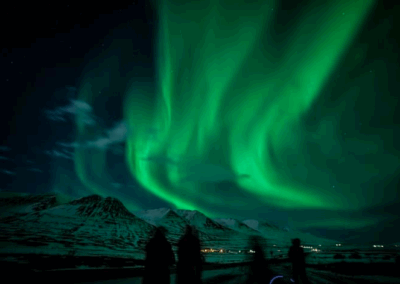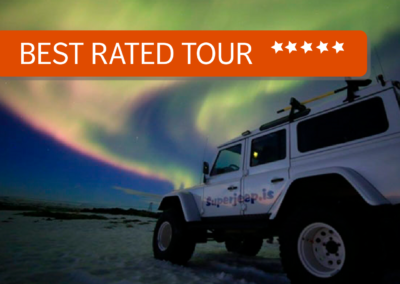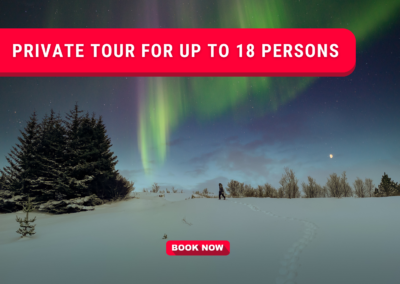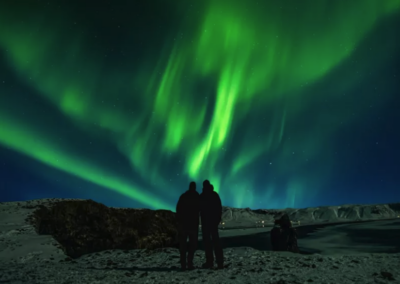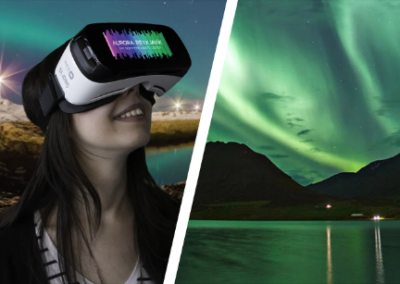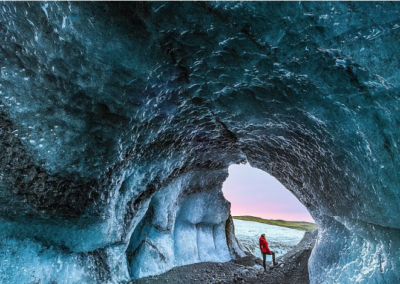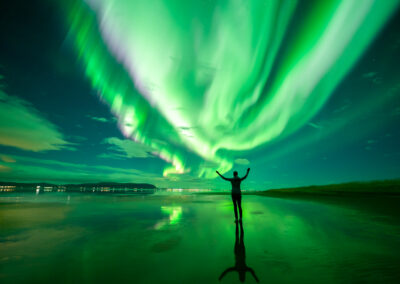How Long Do the Northern Lights Last?
JOIN US ON A NORTHERN LIGHTS EXCURSION
Introduction: A Glimpse into Nature’s Light Show
When you think of the Northern Lights, the first thing that probably comes to mind is the magical glow dancing across the Arctic sky in shades of green, purple, and even red. But as much as the aurora captivates travellers, there’s one lingering question that keeps coming up time and time again: How long do the Northern Lights last?
It’s an excellent question, one that’s not as straightforward as you might think. Northern Lights displays are as unpredictable as they are awe-inspiring. Some nights, they light up the entire sky for hours, while on others, they may appear for only a few minutes – sometimes in a much softer glow. But, more often it can come in waves of intensity known as Substorms.
Let’s take a deep dive into the science, timing, and some of the most thrilling insights to help you understand what goes into the length of an aurora show, and maybe give you a better chance of witnessing one of nature’s greatest spectacles.
NORTHERN LIGHTS SUPERJEEP EXCURSION
What Causes the Northern Lights? A Quick Science Lesson
Before we can answer the burning question of how long the Northern Lights last, we need to understand what causes them in the first place.
The aurora borealis (aka, the Northern Lights) is born from solar activity.
To put it simply, the sun sends charged particles flying toward Earth. These particles get caught in our planet’s magnetic field and interact with gases in the atmosphere, like oxygen and nitrogen. The result? That magnificent light show we all know and love.
In the words of Brian Cox, the Northern Lights provides the visible proof of our magnetic field – keeping us all safe for another day.
Different gases produce different colours: oxygen gives off green and red hues, while nitrogen produces purple and blue shades.
This is where the magic happens – solar winds stirring the atmosphere into a celestial display that can last for minutes or hours depending on a variety of factors.
Iceland, being positioned under the auroral oval, is one of the prime locations to catch this light show. But when you’re waiting for that flash of green in the Arctic sky, it’s good to know what could determine whether you’re lucky enough to see it, and for how long.

Northern lights over Þingvallavatn, in the Golden Circle
How Long Do the Northern Lights Last in a Single Display?
The length of a Northern Lights display varies significantly. Some auroras last a few minutes, while others can persist for hours.
The duration depends primarily on solar activity and atmospheric conditions, but that’s not all. The aurora isn’t just a one-time event – it ebbs and flows, with bursts of intensity followed by lulls.
Think of it as nature’s way of keeping you on your toes. (I guess that’s the same with Iceland’s recent volcanic eruptions also!)
In general, auroras are brief bursts of colour and light, but they can repeat in cycles throughout the night.
During these cycles, they’ll grow in intensity, and then fade out before potentially coming back stronger later.
It’s not uncommon for the Northern Lights to make an appearance and then vanish, only to pop back up a few hours later with even more intensity.
Can the Northern Lights Last for Several Hours?
Yes, absolutely!
While you might get lucky with a few fleeting minutes of the aurora’s magic, there are nights when the lights will stick around for a more extended performance.
In fact, solar storms can cause auroras to last for several hours, sometimes even longer. These solar events send charged particles into the atmosphere at much higher intensity, resulting in an extended aurora show.
In Iceland, it’s possible to catch these extended auroras from September to March, as the nights are long and dark, which gives you the best chance to see the show stretch out over a long period.
Still, one night’s aurora might last just a few minutes, while another could go on and off throughout the evening, so patience is key.

An explorer enjoys a beautiful northern lights display in the wilderness
Do the Northern Lights Last All Night?
Now, let’s get to the fun part. Will you be able to watch the Northern Lights all night long?
The short answer: Not likely.
While the Northern Lights can sometimes appear in long stretches, they are often not visible all night.
There are breaks in the aurora’s performance where the sky may seem dark, but don’t let this fool you. The aurora often comes back after a quiet spell.
For the best chance of a prolonged display, you’ll want to venture out after dark when solar activity is expected to be high, and stay vigilant – sometimes the lights show up just when you least expect them.
Substorms: The Surprising Little Boosts That Can Make the Northern Lights Last Longer
Let’s throw a curveball into the mix: aurora substorms.
These mini-solar events are like the unpredictable (Icelandic) cousin of the main aurora show.
Substorms occur when the Earth’s magnetosphere gets a sudden influx of solar wind, temporarily intensifying the aurora’s activity.
During a substorm, the Northern Lights can go from a gentle shimmer to an intense, swirling spectacle, lasting anywhere from a few minutes to several hours.
In these bursts of energy, the aurora’s colour and intensity can change dramatically, giving you a show that’s even more thrilling.
For aurora enthusiasts, substorms are like a sudden, unexpected encore to an already great performance.
If you’re standing outside gazing up, you might even see that on this occurrence the Aurora may suddenly start to brighten and dance more hurriedly, as well as pushing the display further South from the horizon to over your head and beyond.
NORTHERN LIGHTS SMALL GROUP EXCURSION

Rare red northern lights during a solar storm
How Substorms Develop: The Science Behind the Surge
Substorms are caused by a sudden reconfiguration of the Earth’s magnetosphere, often due to an increase in solar wind intensity. Here’s a breakdown of the process:
- Solar Wind Impact: Solar winds, streams of charged particles from the Sun, can impact the Earth’s magnetosphere, triggering energy buildup.
- Magnetic Field Reconnection: This leads to a “magnetic reconnection,” where the lines of the Earth’s magnetic field snap back into place. This releases a burst of energy, which accelerates charged particles along magnetic field lines toward the poles.
- Auroral Intensification: The result is a significant brightening and intensification of the aurora, often visible as swirls and waves of light moving rapidly across the sky. The duration of a substorm can vary but typically lasts for several minutes to a couple of hours.
Substorms can happen suddenly, and their unpredictability adds an element of surprise to aurora-watching.
These bursts of light are more intense and have more defined shapes than the typical, steady glow of an aurora, making them a thrilling spectacle for viewers.
Interpreting Northern Lights Data: How Experts Predict the Duration
Northern Lights displays are incredibly dynamic, and predicting how long they’ll last can be tricky.
However, thanks to modern technology and a bit of scientific wizardry, we have tools to estimate the likelihood and duration of an aurora.
The key is monitoring solar activity and the Earth’s magnetic field in real-time.
One of the most essential tools in the aurora prediction game is the Kp Index.
This index measures geomagnetic activity on a scale of 0 to 9, with higher numbers indicating stronger aurora displays.
When the Kp Index hits 6 or higher, you can expect more intense auroras that might last longer, especially in regions like Iceland.
But, that’s often only what a quick Google will tell you to look out for. For those wanting a better chance of seeing the Northern Lights it’s worth monitoring the K number shown on Magnetometers.
For example, the Kp Index is an average of the K numbers from the past 24 hour cycle. In simplicity, the K numbers can show huge spikes in activity where for moments of the night, the Aurora intensity can mimic the likes of a Kp 7 or 8 display, even when the predictions are low. This is why we always recommend joining a guided tour with a local expert.
By tracking solar wind speed, solar flares, and the Kp Index, experts can predict the chances of an aurora and give you a rough idea of how long it might last.
Of course, these predictions are not foolproof – after all, nature doesn’t stick to schedules. But knowing what the experts are seeing can help you maximize your chances of a prolonged Northern Lights experience.
Why the Aurora Forecast is Important: Planning for the Perfect Viewing Experience
If you want to maximize your chances of catching the Northern Lights and watching them for hours, checking the aurora forecast is a must.
These forecasts are based on data from space weather stations and satellites, which monitor solar activity and geomagnetic conditions.
The forecast will give you key information, such as the Kp Index, cloud cover, and solar wind speed.
Armed with this knowledge, you’ll know when and where to go to get the best view.
For example, if the forecast predicts high solar activity in a remote area with clear skies, you can plan your trip accordingly – often with great success and a few days prior or planning.
Remember, while these forecasts can give you an idea of when to expect a long display, they can’t guarantee the exact duration.
The Northern Lights are inherently unpredictable, but the more information you have, the better your chances of seeing an extended show.
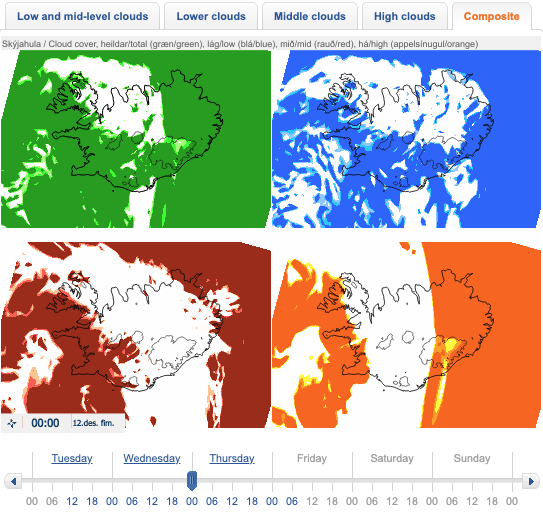
Northern lights forecast detailing the cloud cover over Iceland
What Does the Camera Capture vs. the Human Eye?
Alright, let’s get down to business: what does your camera capture that your eyes can’t?
In simple terms: a lot.
When you’re standing under the Northern Lights, you’ll see the glowing green shimmer with your eyes, maybe a bit of red or purple on a good night.
But when you break out your camera, things get a lot more vivid. That pale green glow becomes a rich, swirling tapestry of colours – greens, pinks, purples, and sometimes even reds.
This is because cameras capture more light than the human eye can, especially during long exposure shots.
They’re able to record the intricate movement of the aurora that our eyes just can’t keep up with. So, while you might see a pretty display in real-time, your camera is likely capturing something far more dynamic.
Nowadays, however, many smartphones even have a decent amateur level of video recording in low-light.

Mythology of the Northern Lights in Iceland
The Northern Lights have fascinated people for centuries, and various cultures have developed their own myths and legends to explain this celestial phenomenon.
In Iceland, the Northern Lights are deeply rooted in folklore and have been interpreted in unique ways.
- The Viking Connection: Icelanders have long believed that the auroras were the glow of the Valkyries’ armor. The Valkyries, the female figures who chose who would live and die in battle, were said to ride through the skies, their shining armor creating the colourful displays of the Northern Lights. The aurora borealis was considered a divine spectacle, signaling the presence of these powerful female warriors.
- The Maiden’s Dance: Another popular Icelandic belief held that the Northern Lights were the spirits of young women dancing in the sky. The shimmering lights were seen as the reflections of their joyful movements. Some stories even suggested that it was bad luck to disturb or look at the lights, as it was believed that those who stared too long might fall ill or have bad fortune.
- The Aurora and Fertility: In some parts of Icelandic tradition, the Northern Lights were thought to have a connection to fertility. It was believed that the lights could bring good fortune to a marriage or encourage fertility among women. Couples hoping for children might pray under the Northern Lights, believing that the magical glow would bless them with offspring.
- Superstitions and Caution: In some Icelandic folklore, it was also considered dangerous to witness the Northern Lights if you were pregnant or had recently given birth. Some believed that exposure to the lights could bring about harm or discomfort for women in these conditions. This caution was tied to the belief that the lights were a force of nature so powerful and unpredictable that they should be respected at all costs.
While these myths have faded somewhat in modern Iceland, they still play a significant role in how the Northern Lights are perceived by locals, adding an air of mysticism and reverence to the spectacle.
What Apps Are Worth Using to Track the Northern Lights?
When it comes to planning your Northern Lights adventure, having the right tools on hand can make all the difference.
Several apps are designed to track solar activity and provide real-time aurora forecasts to help you catch the lights at their best. Here are a few of the most useful apps for aurora hunters:
My Aurora Forecast & Alerts
This app is a must-have for anyone serious about chasing the Northern Lights. It provides a real-time aurora forecast, complete with a Kp Index scale to measure geomagnetic activity.
The app also includes alerts, so you’ll be notified when aurora activity is high in your location. It’s available for both Android and iOS and gives you a great overview of solar activity, cloud cover, and the chances of seeing the aurora.
AuroraWatch UK
Although focused on the UK, this app is helpful for anyone interested in tracking auroras across the Northern Hemisphere.
It offers real-time alerts based on the geomagnetic activity and gives you a clear idea of when auroras might be visible in your area. The app also includes detailed charts showing solar wind speeds and Kp Index updates.
Aurora Alerts
A popular app among Northern Lights enthusiasts, Aurora Alerts provides real-time notifications when aurora activity is occurring.
The app lets you track solar wind speeds and the Kp Index, and it also has a useful map feature that shows the best locations for aurora viewing based on current geomagnetic conditions.
Space Weather Live
For those who want to dive deep into the science of aurora forecasting, Space Weather Live offers detailed information on solar wind, sunspots, solar flares, and the Kp Index.
This app is more data-driven and caters to those who want to follow the intricacies of solar activity closely. It’s available on both Android and iOS and is a fantastic resource for experienced aurora chasers.
Aurora Forecast
This app offers a detailed view of aurora activity across the globe, including forecasts, cloud cover predictions, and real-time aurora maps.
It is highly rated for its user-friendly interface and reliability, making it an excellent tool for those who want to plan their trips and ensure they’re in the best location to see the lights.

Are the apps good enough to help you see the Northern Lights?
In short: No.
The apps are fantastic and handy assistant that can provide a short-cut to some real-time data, and with the real-time alerts they can certainly increase your chances, but they only help you with one piece of the puzzle.
To see the Northern Lights at the best spots, under a tapestry of stars, and crucially, safely – we always recommend our handpicked guided tours.
I know, I know, we would say that right? But, the experience of reading the data, reading the weather, and even the phases of the moon is something you want in the hands of a pro so you can focus all of your energy on enjoying the experience.
It’s a once in a lifetime opportunity – don’t put it all in the hands of an app.
Conclusion: The Northern Lights Are Worth the Wait
While the Northern Lights are notoriously unpredictable, one thing is for certain: when they show up, they put on a spectacular display.
Whether they last for a few minutes or a few hours, each display is unique, and every moment is worth the wait.
By keeping an eye on aurora forecasts, understanding the science behind the phenomenon, and heading to one of Iceland’s prime locations, you’ll maximize your chances of witnessing the lights in all their glory.
And don’t forget: the Northern Lights are not just a natural wonder but also a cultural and mythological treasure.
The rich folklore of Iceland gives an extra layer of depth to the experience, making the aurora not just a light show, but a mystical, almost sacred event.
So, grab your warmest jacket, check the forecast, and get ready for the magic that is the Northern Lights – whether they last for a few minutes or stretch into a night-long shebang, the sheer unpredictability is 100% part of the experience!



